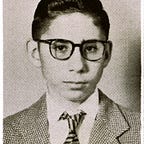My Photograph of Wes Craven
At the age of eight, my first horror film was Abbot & Costello Meet Frankenstein. The year was 1950, and I was with my father in Buenos Aires. The sight of Bela Lugosi’s Dracula opening the coffin lid from inside made me shelter my face in both of my hands.
Since then, I have not been a fan of horror movies. But I did get to photograph one of its masters — Wes Craven — who died this week of brain cancer.
At the time, I worked with Vancouver Sun writer John Armstrong. As a former punk-rock singer and leader of The Modernettes, Armstrong spent many sleepless nights watching television (after gigs, of course). During those wee hours, he became an expert in horror films and film noir, making him rather particular about new material from those genres.
Needless to say, Armstrong did not approve of Wes Craven’s ventures into writing novels — as you’ll can see from his text in the review below:
The above photograph is an example of what happens to images when they are reproduced in newsprint. Before the advent of scanners, the only way to get a “true black” from a photograph on newsprint or magazines was through glossy 8x10s, which explains the previous century’s preference for glossies. Matte-surfaced photographs produced muddy blacks.
For those interested, the technical info for my Wes Craven portrait is as follows: I used a Mamiya RB-67 Pro-SD with the marvelous floating element macro 140mm lens. I loaded it with Kodak Plus-X rated at 100 ISO. (I continue to shoot with this camera and with this film. Now I opt for Kodak 100 TMax, which I process with Kodak T-Max Developer.) Finally, the light for the photograph was an American-made Dynalite flash inside a 3x4 ft Chimera softbox placed really close. I had a second Dynalite with a narrowing grid behind as a hair light.
The funny edge on the Wes Craven photograph comes not from photo-editing software or an iPhone app, but from my filing the metal neg(ative) holder of my Beseler 23C enlarger. At one time a filed edge signified two things: the photographer had not cropped the negative, but he had cropped inside the camera.
The filed edge showed what was called a full-frame photograph. Since it was impossible to file a negative carrier the same twice, it hinted that the print was printed by the photographer who had taken the photograph. Now in Photoshop (or Instagram and the like), these filed edges can be added to digital files without a problem.
Originally published at Alex Waterhouse-Hayward.com.
If you enjoyed this, please hit the green “Recommend” button below so others might also enjoy it.
